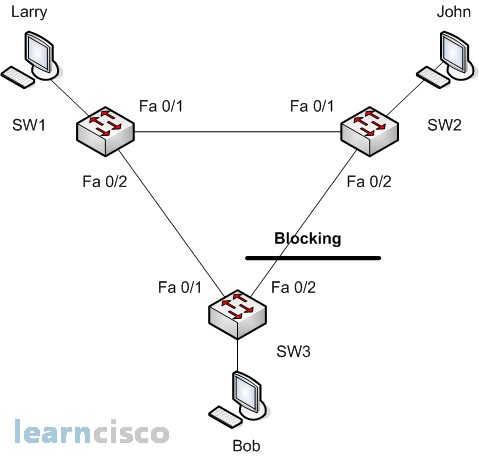When LAN designs require multiple switches, most network engineers include redundant Ethernet segments between the switches. The goal is simple. The switches might fail, and cables might be cut or unplugged, but if redundant switches and cables are installed, the network service might still be available for most users.
LAN designs with redundant links introduce the possibility that frames might loop around the network forever. These looping frames would cause network performance problems. Therefore, LANs use Spanning Tree Protocol (STP), which allows the redundant LAN links to be used while preventing frames from looping around the LAN indefinitely through those redundant links.
For the INTRO exam, you need to know why STP is necessary, and a few details about how it works. For the ICND exam, you need to know the details of STP, as defined in IEEE 802.1d, in more detail.
IEEE 802.1d Spanning Tree
The spanning tree algorithm places each bridge/switch port in either a forwarding state or a blocking state. All the ports in forwarding state are considered to be in the current spanning tree. The collective set of forwarding ports creates a single path over which frames are sent between Ethernet segments. Switches can forward frames out ports and receive frames in ports that are in forwarding state; switches do not forward frames out ports and receive frames in ports that are in blocking state.
Here is shown a simple STP tree with one port on SW3 in blocking state.

When Larry sends a broadcast frame, the frame does not loop. SW1 sends a copy to SW3, but SW3 cannot forward it to SW2 out its port 0/2 because it is blocking. SW1 sends the broadcast to SW2, who forwards it to SW3, but SW3 ignores frames that enter port 0/2. However, STP causes some frames to use a longer physical path for the sake of preventing loops. For instance, if John wants to send a frame to Bob, the frame has to go from SW2 to SW1 and then to SW3-a longer path than is physically required. STP prevents the loops, but you then have to live with a less-efficient path for some traffic. Of course, at LAN speeds, a user typically wouldn’t notice any difference in performance unless the network was also badly congested as a result of the traffic patterns.
If the link between SW1 and SW3 fails, STP converges so that SW3 no longer blocks on its 0/2 interface. For instance, in Figure 2-2, that link has failed, and STP has converged.
Our Recommended Premium CCNA Training Resources
These are the best CCNA training resources online:
Click Here to get the Cisco CCNA Gold Bootcamp, the most comprehensive and highest rated CCNA course online with a 4.8 star rating from over 30,000 public reviews. I recommend this as your primary study source to learn all the topics on the exam.

Want to take your practice tests to the next level? AlphaPreps purpose-built Cisco test engine has the largest question bank, adaptive questions, and advanced reporting which tells you exactly when you are ready to pass the real exam. Click here for your free trial.
